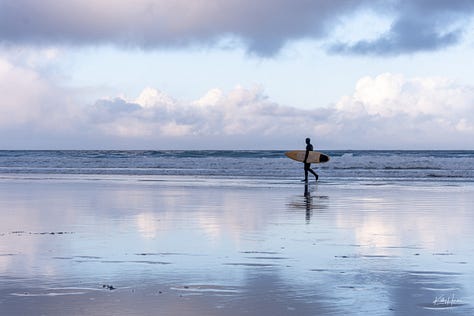Could You Move from North America to Europe–Part 3
Do you have the emotional strength and support needed to meet unexpected challenges?
Welcome to “The Journey”, a newsletter from my little corner of the internet!
In this bi-weekly newsletter, I share experiences and observations from day-to-day life and the occasional broader “life lesson”, bigger projects I’m working on, and details I think you might find interesting about my recent photography or writing efforts.
In this issue, I’m continuing to discuss the topic of “could you move from North America to Europe”, first raised a few months ago in a thought-provoking post by Gregory Garretson.
“The Journey” is a reader-supported publication and arrives in your inbox every second Sunday for free! And if you wish, you can opt in for a paid subscription ($5CAD/month or $50CAD/year), and you will receive a surprise item in the mail as a “thank you”!
Life at Large
“Do you have the emotional strength and support needed to meet unexpected challenges?”
When considering this 3rd question of 10—originally posed by Gregory Garretson in his guide to assessing whether you're suited for moving abroad—I keep coming back to an important distinction. I’m reflecting on this from the perspective of someone who had the privilege of choosing to move.
Michal and I weren’t fleeing conflict, persecution, or forced displacement when we left New Westminster, BC, Canada, for Porto, Portugal. We wanted to move, we were seeking a new way of life, and being closer to Michal’s daughter, and the rest of his family. We chose Porto as our new home, planned every detail, and made the transition on our terms. And yes, even with all that control, it was still hard at times. Thinking about that makes me feel deeply for those who migrate under duress, fear, or great personal risk.
Having the ability to plan and prepare provided us with a sense of control, reinforcing our feelings of choice and competence in a new situation. We also made specific plans with my family and our close friends for how and when we would stay in touch. That was important to us as part of maintaining social connections and close relationships with those we were moving farther away from, another factor in emotional well-being.
I have always been a fan of Kenneth Thomas’s work on intrinsic motivation where he talks about a sense of meaningfulness, a sense of choice, of competence, and of progress being the pillars of intrinsic motivation, and driving engagement in the work at hand. Those principles “sort of” fit in the context a big move, but I think the slightly broader Self-Determination Theory is a better fit in this situation.
Self-Determination Theory outlines three core psychological needs that contribute to our emotional well-being:
Autonomy – Feeling like you have control over your decisions
Competence – Believing you can adapt and succeed in a new environment
Relatedness – Maintaining meaningful social connections
If any of these elements are missing, adjusting to a new home can be emotionally difficult. For example:
If you had no (or little) choice about when or where you moved, your psychological need for making the decision autonomously was not being met. This could even happen within a family, or a relationship, if one partner is more invested in the move, with the other tagging along out of a sense of obligation.
If you lack confidence in learning a new language or culture, you might not feel very competent. Let me re-state that: You WILL feel incompetent at times, you have to trust it will pass, and that you ARE in the driver’s seat with learning the language and ways of your new home.
If your social ties weaken back “home”, and you struggle to make new ones, you may experience a loss of connection. Even time zone differences can contribute to this–somehow, having to wait until 3:00pm to tell my parents about the cool cloud patterns I saw at sunrise can feel disconcerting. I guess these are the times we live in, we are used to instant connection.
However big or small these challenges, how they weigh on you can add up, making it harder to feel at home in a new place.
This brings me to a quote that feels fitting for a segue:
“No matter where you go, there you are.”
– The Adventures of Buckaroo Banzai Across the 8th Dimension (1984)
In other words, moving won’t change the core of who you are.
With this in mind, it’s worth asking yourself,
“Right now, in my current life, do I have the emotional strength to handle unexpected challenges? Do I have a support system you can rely on?”
Maybe you do, maybe you don’t, either way it’s ok. But taking a moment to consider where you are at with these may prove valuable. These questions also make me think back to an episode of a podcast I listened to a few years ago; No Stupid Questions with Angela Duckworth and Mike Maughn.
If you are interested, you can find the episode here:
Mike and Angela were discussing self-compassion, which may be relevant here. Basically, they talked about extending the same basic compassion that we would for someone else, to ourselves. Radical and weird idea, isn’t it?
If another person came to me and said, “I’m an idiot when it comes to languages, I’ll never learn Portuguese,” I’d be quick to tell them they definitely aren’t an idiot, Portuguese is a difficult language and it will take time to learn, and I already see how they are getting the hang of the basics.
So why do I regularly tell myself that I’m an idiot when it comes to languages and I’ll never learn Portuguese? And why do I let it go unchallenged, as if it is a truth? I’ll even repeat it over and over in my head, like a mantra.
Of course, there is a survey you can take to see where you sit with regard to self compassion. It’s called the Self-Compassion Short Form, developed by Raes et al., and it’s interesting. It’s not about calculating a “score” (unless it’s being used for research), I think the value is in asking yourself the questions, and really considering your self-talk. For example, I was feeling pretty positive about the questions, until I read question 9:
“When I’m feeling down I tend to obsess and fixate on everything that’s wrong.”
They might as well have written that as: “When Kathy is feeling down, Kathy tends to obsess and fixate on everything that’s wrong.” I felt a bit called out!
Before our move, I knew I had a habit of ruminating—what I have affectionately nicknamed my hamster wheel of doom. When something bothered me, I would hop onto the hamster wheel, dwelling on the issue, replaying negative thoughts over and over. The more I ruminated, the more stressed I became, creating a cycle that was hard to break. If running on the hamster wheel of doom burned calories, I’d be in great shape!
At a point, I felt paralyzed by my situation, and I visited a Cognitive-Behavioural therapist where I learned about the process of recognizing my thought patterns, and consciously reframing them. I was getting a bit better at it by the time we were ready to move, but I knew changing locations wouldn’t magically erase my tendency to ruminate. In fact, there was a real chance I would struggle MORE as I faced new and unfamiliar challenges.
But after moving to Porto, I noticed I was actually spending less time on the hamster wheel. Why?
I don’t know how much my tendency to ruminate weakened with the move; the main change was that I left behind my biggest source of stress and rumination: my job.
With the biggest source of stress in my life from that time in the rear-view mirror, I have more mental space to recognize when I’m slipping into unhelpful thought patterns, and I can take steps to shift my mindset.
An example of one of the techniques that I use often is challenging my "always" and "never" statements:
"I’ll never make new friends in Porto."
"I’ll never learn the language."
"It’s always raining."
When I notice my negative self-talk, the test I give myself is this: if someone said this to me, what would I think of the statement? I would likely recall the last day it didn’t rain, looking for evidence that it isn’t ALWAYS raining, and I would offer that “evidence” as a reframe, or at least as encouragement. These days I offer that evidence to myself to help me reframe the negative thought.
Instead of, "It’s always raining," I remind myself, "February is a rainy month in Porto, but spring is coming soon." Besides, Porto is a beautiful city in the rain, and some of my favourite photographs I have taken here have been in the rain, or after the rain, when the colours are rich, and the puddles are full of reflections, but I digress.
I also find that I’m less inclined to complain here in Porto. That may be partly because I have fewer reasons to complain, but also because it feels a bit uncouth to grouch about a country that has welcomed us so warmly. There is another theory that probably applies to this as well, one that outlines our tendency to adjust our behaviour to be more socially accepted, but that’s a discussion for another day.
Annnd…that brings us back to social connections. We have made a conscious effort to remain connected with our family and friends in Canada, and we have made new friends in Porto, who have become part of our support network. Making new connections didn’t happen immediately, rather, it was a bit of a slow process.
Initially, I forced myself to become a “joiner”. I joined groups I met on Facebook, and I responded to requests to meet over coffee in online “expat” groups. The upside of those efforts was I met quite a few people that way. The downside, or rather, the reality, was I had little in common with most of the people I met that way, beyond “I used to live there, and now I live here”, geographical connection. Of course, there are a few exceptions, people I just hit it off with, and we have become friends. For the most part, though, it wasn’t until I started joining Meetups for activities that have a keen interest in photography and writing that I began to meet people I had a lot more in common with. At that point I began to feel like I had a community, a social network here in Porto.
Many of my new friends in Porto have a shared understanding of the experience of moving and re-establishing themselves in a new place, and they have become a support system when I become discouraged by the struggle of learning a new language, the slow pace of immigration procedures, or feeling disconnected from local politics and priorities, as can happen.
I think my closing thought on the question, “Do you have the emotional strength and support needed to meet unexpected challenges?” is, even if you don’t feel confident right now that you do, there are active steps you can take to improve your resilience and acquire the tools to become more emotionally ready to tackle the challenges that come with a big move. At the least, you can practice self-compassion as you navigate life’s challenges wherever you are now, and in the future.
I’m also going to point out that I have no formal education or training in these matters. I have a deep curiosity about what makes people, myself included, respond the way they do to different situations.
Learning techniques to improve my own resilience feels empowering, and that motivates me to keep learning. I’d be curious to hear what motivates you to keep learning and growing as a person?
Is it discovering what it will take to move toward a big goal, a desire to improve relationships that are important to you, or just the high of continuous learning? Let me know!
If you are just joining this discussion of Garretson’s “10 Questions” here are some links to help you get caught up:
Previous post | Next post | Start at the beginning
Projects and Events
I was away for much of the last two weeks, but before I left for a photography workshop on Lofoten, Norway, I was pushing hard to get Mom’s story finished. We are finalizing the last chapters, and Mom has a lot of memories of those years when she first moved from Liverpool, England to a remote village on the West coast of British Columbia, Canada. The final chapters are also where we wrap up the themes of the overall story. We didn’t quite get it finished before I left, and that’s ok. We would rather have the project take a little longer, but be a more complete account of Mom’s experiences, than rush it. We are still on schedule to have the last chapters published on Substack by the end of March.
If you are a new reader, here is a link to the beginning of Mom’s story:
Chapter One - Born into War
Air raid sirens wailed their rising and falling tones into the night air. In the darkness Florence helped her mother into the air raid shelter in the back garden of No. 2 Crofton Crescent. Florence would have preferred to stay in the comfort of the house, even in the dark, but her father James worked as an Air Raid Precautions (ARP) Warden. Although he …
Writing
As I mentioned above, I had set myself a deadline of January 30th to finish Mom’s story. I missed that deadline–there was just too much back and forth over the final chapters–and that’s no problem at all! I NEED to set myself deadlines, that’s how I keep my butt in the chair and make progress.
No deadline, no progress!
I’m also ok to move a deadline or adjust the project plan, if it is going to lead to a better end product. When I get home, I’ll spend my first writing session updating my writing plan.
What tools do you use to keep you on task for self-directed projects? I’d love to add more tools to my toolbox, so I’m not a one trick pony, when it comes to keeping myself on task!
Photography
I have just spent a glorious week photographing the Lofoten Islands in Norway. I was amazed by the natural beauty of the mountains, the fjords, and the weather. We had a bit of everything–sunshine, rain, sleet, snow, and wind!
I was part of a photography workshop, there were six of us from all around Europe and North America. Sam from Samuel Scicluna Photography was our guide. This is the second time I have taken one of Sam’s workshops, and I highly recommend him as a guide (I also went to Iceland with his tour in 2022). He knows Lofoten very well, and was able to take us to the best locations for the weather on any given day. Several of us had a conversation about whether it’s better to book self-directed photography trips, or join a tour. We all agreed that for locations where severe weather is a factor, it will almost always be a more productive trip if you go with a guide. We also agreed in the value of spending time with other photographers, discussing the composition of images, editing techniques, and workflow. We learned from each other, as well as from Sam, and the week was a rich experience.
I took a LOAD of images, and I have only just started editing them. I have added a few here, and there are more in a new gallery on my website, if you want to take a look. I have all the locations written down, but I haven’t had time to match the images to the locations yet. I’ll get to it, it’s just been a real whirlwind this week!






Last Thoughts
Thank you for following along as I share odds and ends from life and creative pursuits, and to those of you who opted in for a paid subscription, THANK YOU! There is a small token of my gratitude on its way to you in the mail for new paid subscribers.
There is also a little “bonus” at the end of this newsletter for paid subscribers, this week it’s a short video greeting from beautiful Vik beach on Lofoten.
As always, I love hearing from you - your comments, questions, suggestions, or just a quick hello, they are all very welcome!
Até à próxima! (Until next time!)
Kathy
Keep reading with a 7-day free trial
Subscribe to The Journey to keep reading this post and get 7 days of free access to the full post archives.





